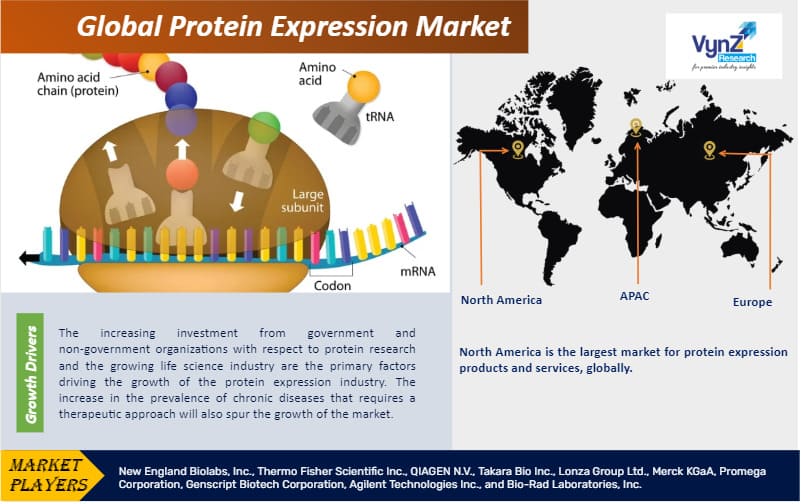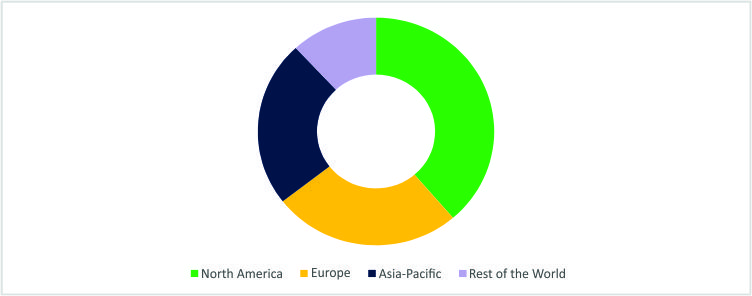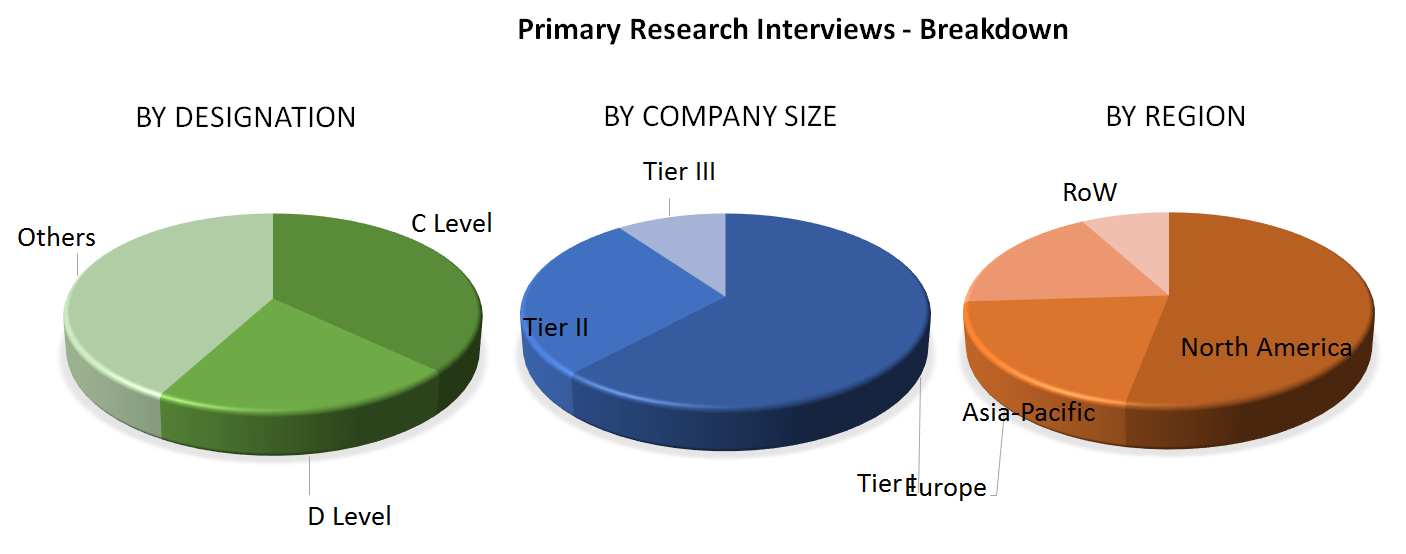Global Protein Expression Market – Analysis and Forecast (2026-2035)
Industry Insights by Product & Services (Expression Vectors, Competent Cells, Reagents, Instruments, Services), by Systems (Prokaryotic Expression Systems, Yeast Expression Systems, Mammalian Cell Expression Systems, Algal-Based Expression Systems Insect Cell Expression Systems, Cell-Free Expression Systems), by Application (Therapeutics, Research, Industrial), by End-User (Academic Research Institutes, Contract Research Organizations, Pharmaceutical And Biotechnology Companies, Others), and by Geography (U.S., Canada, Germany, U.K., France, China, Japan, India, and Rest of the World)
| Status : Published | Published On : Oct, 2025 | Report Code : VRHC1025 | Industry : Healthcare | Available Format :

|
Page : 178 |
Global Protein Expression Market – Analysis and Forecast (2026-2035)
Industry Insights by Product & Services (Expression Vectors, Competent Cells, Reagents, Instruments, Services), by Systems (Prokaryotic Expression Systems, Yeast Expression Systems, Mammalian Cell Expression Systems, Algal-Based Expression Systems Insect Cell Expression Systems, Cell-Free Expression Systems), by Application (Therapeutics, Research, Industrial), by End-User (Academic Research Institutes, Contract Research Organizations, Pharmaceutical And Biotechnology Companies, Others), and by Geography (U.S., Canada, Germany, U.K., France, China, Japan, India, and Rest of the World)
Industry Overview
The Global Protein Expression Market was registered at USD 2.85 billion in 2025 and is estimated to reach USD 5.86 billion by 2035 and is projected to grow at a CAGR of 12.8% during the forecast period (2026-2035).

Protein expression is the process of synthesizing, regulating, and modifying proteins within a living organism. The protocol for expression of proteins makes use of expression vectors, competent cells, reagents, instruments, and services. The reagents are estimated to hold the largest share due to the large volume used in the bio-experiments. The significant growth in the protein expression industry is primarily due to the increasing funds from government and non-government organizations for protein research, the soaring prevalence of chronic diseases, rising life science industry.
Protein Expression Market Segmentation
Insight by Product & Services
Different types of products and services offered by the market players are expression vectors, competent cells, reagents, instruments and services. Reagents held the largest share of more than 50% in the market in 2020, globally. The increasing number of research and development activities in lifesciences industry is the key factor leading to the growth in the protein expression reagents market during the forecast period.
Insight by Systems
Among the various systems being used in the market, the prokaryotic expression system is the largest contributor in the protein expression market , globally. This category includes Escherichia coli systems and other prokaryotic expression systems. The largest share of prokaryotic expression systems is due to the cost-effectiveness, as it is less expensive than other available categories; and the wide usage of E.coli systems in industries. Other types of systems used in the market include yeast systems, mammalian cell, insect cell, cell-free systems, and algal-based systems.
Insight by Application
Based on application, the market is categorized into therapeutics, research, and industries. The increasing number of chronic diseases on a global level led to the application of protein expression majorly in finding therapy for chronic diseases. Also, the increasing number of life science and bio-pharmaceutical industries also adds to the largest contribution of the therapeutics category to the protein expression market. Other key applications include research purposes and the commercial production of proteins in industries.
Insight by End User
Pharmaceutical and biotechnology companies are the largest end user in the protein expression market. The category’s largest contribution is due to the large production of recombinant proteins for therapeutics, and the growing advancement in technology with respect to protein research. Further, other end users to the protein expression market includes academic research institutes, contract research organizations (CROs), others industries such as food processing, brewery, leather, paper, chemical and cosmetic industries. The CROs are projected to witness high demand and register fastest CAGR of 14.7% during the forecast period.
Global Protein Expression Market Report Coverage
|
Report Metric |
Details |
|
Historical Period |
2020 - 2024 |
|
Base Year Considered |
2025 |
|
Forecast Period |
2026 - 2035 |
|
Market Size in 2025 |
U.S.D. 2.85 Billion |
|
Revenue Forecast in 2035 |
U.S.D. 5.86 Billion |
|
Growth Rate |
12.8% |
|
Segments Covered in the Report |
By Product & Services, By System, By Application and By End User |
|
Report Scope |
Market Trends, Drivers, and Restraints; Revenue Estimation and Forecast; Segmentation Analysis; Impact of COVID-19; Companies’ Strategic Developments; Market Share Analysis of Key Players; Company Profiling |
|
Regions Covered in the Report |
North America, Europe, Asia-Pacific, Middle East, South America and Rest of the World |
Industry Dynamics
Protein Expression Market Growth Drivers
The increasing investment from government and non-government organizations with respect to protein research and the growing life science industry are the primary factors driving the growth of the protein expression industry. The increase in the prevalence of chronic diseases that requires a therapeutic approach will also spur the growth of the market.
The profiling of protein expression using microfluidic technology is being adopted by several research organizations. For instance, a study supported by Cancer Research UK (CRUK), on the Multiplexed single-cell analysis in solid tumors using a miniaturized microfluidic assay. This growing adoption of microfluidic devices in profiling protein will provide manufacturers to advance and explore the opportunities that the technology holds.
Expression Systems: These are the organisms or systems used to produce proteins. Common expression systems include bacteria (such as Escherichia coli), yeast (such as Saccharomyces cerevisiae), insect cells (such as baculovirus expression systems), mammalian cells (such as Chinese hamster ovary cells), and cell-free systems.
Expression Vectors: These are DNA molecules used to transfer the genetic information for protein production into the expression systems. Expression vectors typically contain a promoter, a coding sequence for the protein of interest, and other regulatory elements.
Reagents and Kits: Various reagents and kits are available for protein expression, including cell culture media, antibiotics, transfection reagents, protein purification kits, and detection reagents for protein analysis.
Services: Many companies offer protein expression services, where they provide expertise and infrastructure for the production and purification of proteins. These services are often used by research laboratories, pharmaceutical companies, and biotechnology firms that require proteins for their studies or drug development efforts.
Protein Expression Market Challenges
The market observes major challenges in maintaining the aseptic conditions required to run the experiment, and also in addressing the complexities associated to the purification of the proteins. Moreover, the products and services offered by manufacturers are costly, that will restrain the growth of the global protein expression market.
Protein Expression Market Industry Ecosystem
The number of suppliers in the protein expression market is medium since the products utilized in protein profiling and expression need to follow stringent government regulations. Further, the threat of forward integration is low leading to a low bargaining power of suppliers in the market. The presence of a large number of buyers in the market offers manufacturers revenue growth opportunities in the market.
Protein Expression Market Geographic Overview
Geographically, North America is the largest market for protein expression products and services, globally. The largest contribution of the region is due to the adaptation of technologically advanced products, and the increasing government and non-government funds for protein research. The North American protein expression market is also driven by the surge in the prevalence of chronic diseases, and the growing number of life science and bio-pharmaceutical industries in the region.
GLOBAL PROTEIN EXPRESSION MARKET SHARE, BY REGION (2018)

Moreover, the protein expression industry is expected to be driven by emerging economies of Asia-Pacific, such as China, and India. This leads to the fastest growth in Asia-Pacific at a CAGR of 14.6% during the forecast period. The growth in the region is also supported by the increasing investment in the life science industry and the increase in the prevalence of chronic diseases in the region.
Protein Expression Market Competitive Insight
The market players are launching new and technologically advanced products and services to maintain their competency and market share.
New England Biolabs is an American life sciences company which produces and supplies recombinant and native enzyme reagents for life science research. It also provides products and services supporting genome editing, synthetic biology and next-generation sequencing.
Thermo Fisher Scientific Inc. is an American-headquartered company and global supplier of analytical instruments, laboratory, life sciences solutions, specialty diagnostics, pharmaceutical and biotechnology services.
The major player in the global protein expression market includes New England Biolabs, Inc., Thermo Fisher Scientific Inc., QIAGEN N.V., Takara Bio Inc., Lonza Group Ltd., Merck KGaA, Promega Corporation, Genscript Biotech Corporation, Agilent Technologies Inc., and Bio-Rad Laboratories, Inc.
Recent Developments by Key Players
New England Biolabs is a world leader in the production of reagents for the life science industry has extended its global subsidiary network with the opening of New England Biolabs Korea Ltd. The Republic of Korea is emerging as a global leader in the life science space, as a result of strong public sector support and private sector investments.
Thermo Fisher Scientific his the world leader in serving science which has expanded local operations in Indonesia with the opening of its first official office. The inauguration of the new facility in Jakarta signify a key milestone.
The Protein Expression Market report offers a comprehensive market segmentation analysis along with an estimation for the forecast period 2026–2035.
- By Product & Services
- Expression vectors
- Reagents
- Competent cells
- Instruments
- Services
- By Systems
- Prokaryotic expression systems
- E. coli systems
- Others
- Yeast expression systems
- Saccharomyces systems
- K. Lactis systems
- Pichia systems
- Others
- Mammalian cell expression systems
- Chinese hamster ovary system
- Others
- Cell-free expression systems
- Algal-based expression systems
- Insect cell expression systems
- Baculovirus system
- Others
- Prokaryotic expression systems
- By Application
- Therapeutics
- Research
- Industrial
- By End User
- Academic research institutes
- Contract research organizations
- Pharmaceutical and biotechnology companies
- Others
Protein Expression Market by Region
- North America
- U.S.
- Canada
- Europe
- Germany
- France
- U.K.
- Italy
- Spain
- Rest of Europe
- Asia-Pacific
- China
- Japan
- India
- Rest of Asia-Pacific
- Rest of the World (RoW)
- Brazil
- Mexico
- South Africa
- Other countries

Frequently Asked Questions
Purchase Options
Latest Report
Research Methodology
- Desk Research / Pilot Interviews
- Build Market Size Model
- Research and Analysis
- Final Deliverabvle
Connect With Our Sales Team
- Toll-Free: 1 888 253 3960
- Phone: +91 9960 288 381
- Email: enquiry@vynzresearch.com
Protein Expression Market
